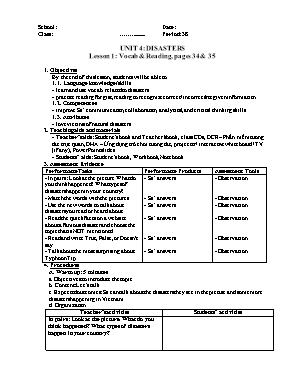Giáo án môn Tiếng Anh 8 - Unit 4: Disasters - Lesson 1: Vocab & reading
1. Objectives
By the end of this lesson, students will be able to
1.1. Language knowledge/ skills
- learn and use vocab. related to disasters
- practice reading for gist, reading to recognize correct/incorrect/not given information
1.2. Competences
- improve Ss’ communication, collaboration, analytical, and critical thinking skills.
1.3. Attributes
- love victims of natural disasters.
2. Teaching aids and materials
- Teacher’s aids: Student’s book and Teacher’s book, class CDs, DCR– Phần mềm tương tác trực quan, DHA – Ứng dụng trò chơi tương tác, projector / interactive whiteboard /TV (if any), PowerPoint slides.
- Students’ aids: Student’s book, Workbook, Notebook.
Bạn đang xem tài liệu "Giáo án môn Tiếng Anh 8 - Unit 4: Disasters - Lesson 1: Vocab & reading", để tải tài liệu gốc về máy hãy click vào nút Download ở trên
Tóm tắt nội dung tài liệu: Giáo án môn Tiếng Anh 8 - Unit 4: Disasters - Lesson 1: Vocab & reading

School: Date: Class: .................. Period: 38 UNIT 4: DISASTERS Lesson 1: Vocab & Reading, pages 34 & 35 1. Objectives By the end of this lesson, students will be able to 1.1. Language knowledge/ skills - learn and use vocab. related to disasters - practice reading for gist, reading to recognize correct/incorrect/not given information 1.2. Competences - improve Ss’ communication, collaboration, analytical, and critical thinking skills. 1.3. Attributes - love victims of nat...Match the words with the pictures. - Use the new words to talk about disasters you read or heard about. - Read the quick facts on a website about a famous disaster and choose the topic that is NOT mentioned. - Read and write True, False, or Doesn't say. - Talk about the most surprising about Typhoon Tip. - Ss’ answers. - Ss’ answers. - Ss’ answers. - Ss’ answers. - Ss’ answers. - Ss’ answers. - Observation. - Observation. - Observation. - Observation. - Observation. - Observation..... - Call some pairs to give their answers. - Give feedback. - Work in pairs, look at the picture and answer the questions. Ss’ own answers B. New Lesson (35’) 1. Pre-Reading (Vocabulary - 15’) a. Objectives: to help Ss improve their vocabulary about disasters. b. Content: tasks a and b. c. Expected outcomes: Ss can name correct natural disasters. d. Organization Teacher’s activities Students’ activities Task a: Match the words with the pictures. Listen and repeat. - Ask Ss to work ...ers they read or heard about, using the new words. - Go around the class to help if necessary. - Pick some Ss to talk about their partner. - Give feedback. - Work with their partner to talk about disasters they read or heard about, using the new words. -Share their answers. Sample answer: I read about a tsunami in Thailand. 2. Pre & While-Reading (Reading – 15’) a. Objectives: to help Ss practice reading for main idea and details. b. Content: tasks a, b, and c. c. Expected outcomes: Ss...cs are mentioned. - Check Ss’ answers. - Read the facts about the disaster and choose the topic that is not mentioned. - Give their answers. Answer Keys: Jess C. How people stayed safe (A can be found in “Where was Typhoon Tip?”, and B can be found in “How much damage did Typhoon Tip cause?”) Task b: Now, read and write True, False, or Doesn't say. According to the website, 1. Typhoon Tip was the biggest tsunami ever. ______ 2. the typhoon affected Japan, South Korea, and Vietnam. _____...- Scan the text to find the key words. Answer keys: According to the website, 1. Typhoon Tip was the biggest tsunami ever. 2. the typhoon affected Japan, South Korea, and Vietnam. 3. Typhoon Tip lasted longer than any other storm. 4. the storm damaged more than twenty thousand homes. - Read carefully and decide True, False, or Doesn’t say. Answer Keys 1. False (The biggest typhoon was Typhoon Tip.) 2. False (It affected parts of many countries including Japan, the Philippines, Nor...and difference in hobbies of the Ss and people in the passages. c. Expected outcomes: Ss can compare and contrast their hobbies with those of the people in the passages. d. Organization Teacher’s activities Students’ activities In pairs: What is the most surprising about Typhoon Tip? - Ask Ss to work in pairs to say the most surprising about Typhoon Tip. - Monitor the class and help them if necessary. - Ask some Ss to share their ideas. - Give feedback. - Work in pairs to answer
File đính kèm:
 giao_an_mon_tieng_anh_8_unit_4_disasters_lesson_1_vocab_read.docx
giao_an_mon_tieng_anh_8_unit_4_disasters_lesson_1_vocab_read.docx

